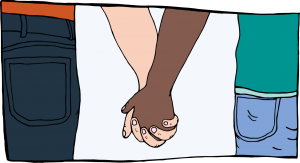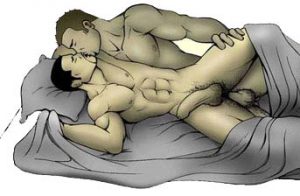homosexuality
 Homoio is the Greek word for ‘same’. So a homophile, literally, is a person who loves someone of the same sex. Homosexuality involves sexual attraction and behaviour. Therefore, the term ‘homophile’ may be considered a euphemism (a ‘nice’ word for something disapproved of) because it suggests that only ‘spiritual’ contact is involved.
Homoio is the Greek word for ‘same’. So a homophile, literally, is a person who loves someone of the same sex. Homosexuality involves sexual attraction and behaviour. Therefore, the term ‘homophile’ may be considered a euphemism (a ‘nice’ word for something disapproved of) because it suggests that only ‘spiritual’ contact is involved.
Homosexuality was considered a crime
In the days when homosexual contacts were severely punished they obviously had to take place in secret, and caused strong feelings of guilt. During the first half of the twentieth century, homosexuality was considered a crime, especially when a younger person (under 21) was involved. At the same time, however, the medical profession came to think of it as a disorder or, more positively, as a certain inclination or preference. A distinction was made between actually practising it, and just having the inclination or feeling. The latter was then said to be ‘homophilia’, which was considered to be much more acceptable, especially since many intellectuals and moralists defended this ‘Greek’ love in their writing.
Acceptation of homosexuality 
But as time passed, also practising homosexuals became more and more accepted. During the second half of the twentieth century, homosexuality was brought into the open by research (especially the great surveys by Alfred Kinsey in 1948), literature (for instance the Dutch writer Van het Reve or Komrij), or by human rights organisations. In the Netherlands this resulted in the legal prohibition to discriminate homosexuals, and the right for homosexuals to marry (see Gay marriage) and adopt children. In most countries in the world, including some that are technologically advanced and call themselves democratic and liberal, homosexuals do not have full human rights, and meet with fierce opposition from moral >fanatics. And even in the Netherlands, there is by no means a full integration of homosexuality into everyday life. The distinction between homo and heterosexuality is maintained very strongly, unfortunately by both categories. This is of course due to the pervading presence of the sexual system.
Homosexuality and lesbianism
 The word homosexual is mainly used for men (people probably associate the word with the Latin word ‘homo’ which means ‘man’), while the word ‘lesbian’ is used for women. Lesbian comes from ‘Lesbos’, the name of the Greek island where the ancient Greek poetess Sappho lived in a community with other women. The words ‘homo’ and ‘lesbo’ are frequently used abbreviations, but the most popular world in the world is of course the English word ‘gay’, which is originally also a euphemism. Young persons with homosexual feelings are in a difficult position in a predominantly heterosexual environment, in which heterosexuality is taken for granted in films, songs, education, and daily conversation. They would like to fit in and often have doubts about themselves. This may explain why, even where homosexuality is fully accepted officially, those who come to categorize themselves as gay, often have vulnerable personalities or need extra support or help from individuals or institutions.
The word homosexual is mainly used for men (people probably associate the word with the Latin word ‘homo’ which means ‘man’), while the word ‘lesbian’ is used for women. Lesbian comes from ‘Lesbos’, the name of the Greek island where the ancient Greek poetess Sappho lived in a community with other women. The words ‘homo’ and ‘lesbo’ are frequently used abbreviations, but the most popular world in the world is of course the English word ‘gay’, which is originally also a euphemism. Young persons with homosexual feelings are in a difficult position in a predominantly heterosexual environment, in which heterosexuality is taken for granted in films, songs, education, and daily conversation. They would like to fit in and often have doubts about themselves. This may explain why, even where homosexuality is fully accepted officially, those who come to categorize themselves as gay, often have vulnerable personalities or need extra support or help from individuals or institutions.
Bisexuality
Some people consider themselves ‘bisexual’. The word ‘biphile’ is hardly used. ‘Bi’ means ‘two’. These people are not satisfied with the homo-hetero dichotomy, and feel attracted to both male and female partners. Although bisexuality (or rather multisexuality) is doubtless one of the ideals of sexual reform, bisexuals look upon themselves as having a distinct identity, and are not necessarily in favour of ‘free love’.

